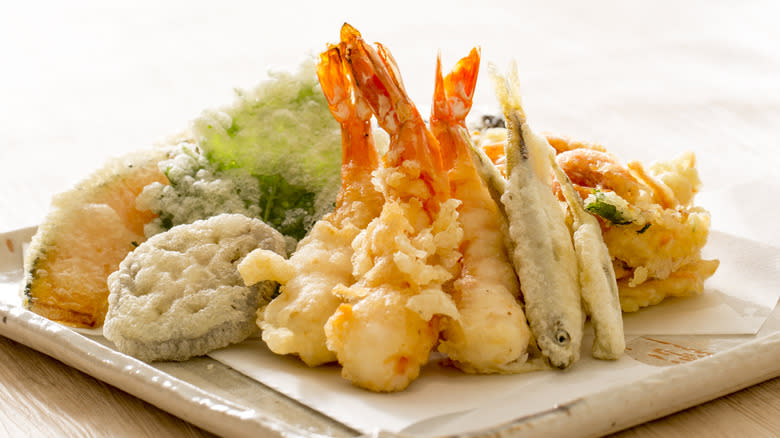How To Keep Tempura Batter Intact Once Your Food Hits The Oil

The light and airy crispiness of deep-fried tempura, along with its mild flavor, are what set it apart from other fried foods. Best suited for vegetables and seafood (especially shrimp), tempura's delicate texture is not difficult to achieve at home but does require using some finesse in its preparation. Authentic Japanese tempura batter is easy to make with just eggs, well-sifted flour, and icy cold water. And if you lack the eggs, a down-and-dirty version can even be made with just flour, cold seltzer water, and a pinch of salt.) Either way, the consistency should be ultra-thin, like crepe batter, to achieve an almost translucent fried coating that allows the flavor of the food to come through.
Tempera's delicate quality is what makes it such a pleasure to eat, but getting that very thin batter to stay on the food as it fries can be a little tricky, as it can easily peel off upon contact with the oil. To prevent this, start by drying any moisture off the foods intended for frying before dipping them in the batter. (Sprinkling them with some salt some minutes before this can help draw out excess moisture.) Then, rather than plopping the items into the oil, gently lower them with long cooking chopsticks or tongs and hold them for a second or two before releasing.
Read more: 21 Delicious Ways To Use Up Leftover Rice
Follow These Tips For Great Tempura

Another method to ensure that your tempura batter stays put is to lightly dredge your ingredients in flour first. This will give the batter something to cling to. Frying in very hot oil with a high smoking point is also important, as tempura cooks quickly, generally in three to four minutes. Tempura is often cooked in small batches and needs to be closely watched for this reason. The temperature factor is crucial to quality, so eating it as soon after frying as possible is best.
The ingredients you choose for your tempura are limited only by your imagination, especially regarding vegetables. Carrots, green beans, broccoli, sweet potato, mushrooms, zucchini, and asparagus are all excellent choices, but pretty much any vegetable will work if you prepare it properly. Stick with low-moisture veggies and slice everything thinly. A thicker vegetable such as a Brussels sprout can be fried if blanched first to ensure even cooking.
When it comes to protein, tempura is usually associated with shrimp, prepared for frying so that their shape is straightened out. This is done because it helps the batter adhere to the shrimp better and keeps it from curling up in the hot oil. But a firm, mild fish works well for tempura, too, and scallops (well-dried) are wonderful. And while chicken tempura is not common, it is possible to make. Like any ingredient in tempura, cutting it into small enough pieces is essential.
Read the original article on Tasting Table.
